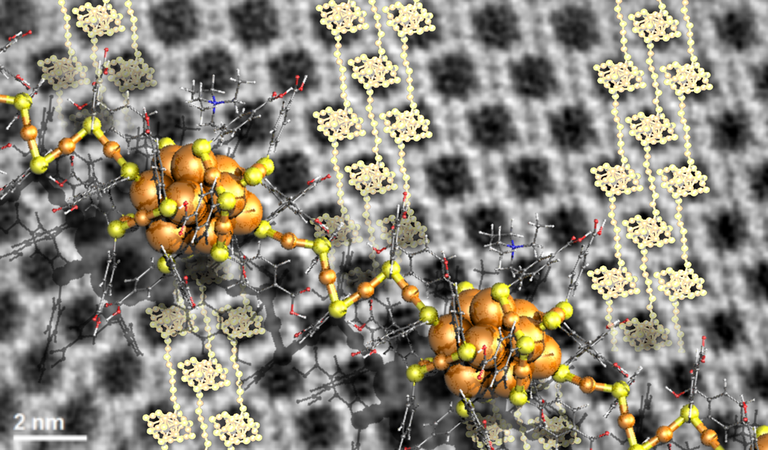Standard solid matter comprises atoms arranged in a crystal lattice. The chemical composition of the atoms and lattice symmetry describes the properties of the matter, for example, whether it is a semiconductor, a metal, or an electric insulator.

Electron microscopy image (background) of an ordered crystal consisting of 25-atom gold clusters. The data could be interpreted by a model of tightly packed polymeric chains of the clusters (light spheres). A close-up visualization of two such clusters, connected by a gold-ligand chain, is shown in front. Image Credit: Sami Malola, University of Jyväskylä.
The symmetry of the lattice may be altered by ambient conditions like high pressure or temperature, which can trigger structural transitions and even convert an electric insulator into an electric conductor - a metal.
Larger identical entities, such as atomically precise metal nanoclusters or nanoparticles, can also arrange themselves into a crystal lattice to develop so-called meta-materials. However, insight into how to promote the growth of these materials from their building blocks has been scarce as crystal growth is a classic self-assembling process.
Now, a study performed by researchers in Singapore, Saudi Arabia and Finland has provided insight into how crystal growth can be engineered by atomically precise metal nanoclusters. They synthesized metal clusters containing just 25 gold atoms, 1 nm in diameter.
These clusters are water-soluble due to the ligand molecules that safeguard the gold. This cluster material is proven to self-assemble into well-defined close-packed single crystals when the water solvent vaporizes.
However, the scientists discovered a unique idea to control crystal growth by incorporating tetra-alkyl-ammonium molecular ions in the solvent. These ions impact the surface chemistry of the gold clusters, and their size and concentration were also noted to affect the shape, size, and morphology of the newly formed crystals.
Extraordinarily, high-resolution electron microscopy images of a few of the crystals exposed that they comprise polymeric chains of clusters with four-gold-atom interparticle connections. The demonstrated surface chemistry now means that there are new ways to create metal cluster-based meta-materials for investigations into their optical and electronic properties.
The electron microscopy imaging was performed at the King Abdullah University of Science and Technology in Saud Arabia, the cluster materials were created at the National University of Singapore, and the theoretical modeling was performed at the University of Jyväskylä, Finland.
The study was published in the November 10th, 2022, issue of the journal Nature Chemistry.
Journal Reference:
Yao, Q., et al. (2022) Supercrystal engineering of atomically precise gold nanoparticles promoted by surface dynamics. Nature Chemistry. doi.org/10.1038/s41557-022-01079-9.